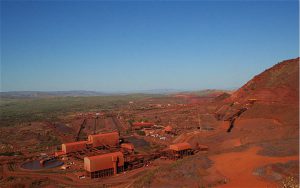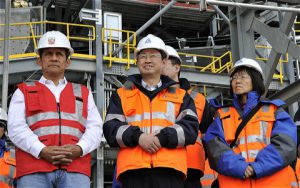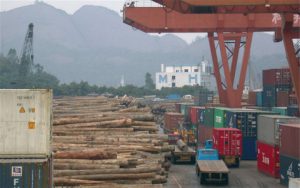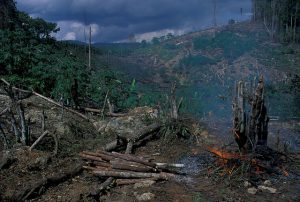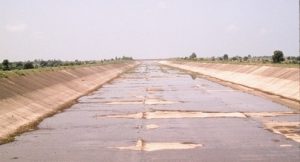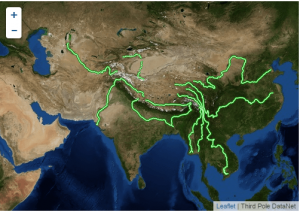As APEC leaders gathered in Beijing, President Xi Jinping announced a US$40 billion investment to establish a Silk Road Fund to build infrastructure in Central Asia. It comes on top of $50 billion for the new Asian Infrastructure Investment Bank to spend, triggering online talk of a 4 trillion yuan “Chinese Marshall Plan”, though there has been no official confirmation.
chinadialogue asked Asia Development Bank‘s senior energy consultant Shen Yiyang what’s needed to ensure regional cohesion and harmony.
chinadialogue (CD): What do you think about the talk of China having a four trillion yuan overseas investment programme?
Shen Yiyang (Shen): So far I haven’t heard any official word on a four trillion yuan scheme. It’s clear China is ramping up overseas investment, given recently confirmed credit lines to the Silk Road Economic Belt, and Maritime Silk Road countries of South and South East Asia. There are also newly-founded institutions — BRICS Development Bank led by China, AIIB, and now the Silk Road Fund. It might not be officially referred to as a four trillion yuan plan, but I think the total figure is about right.
CD: Where is this money coming from, and which sectors will it go to?
Shen: It’s hard to say. First, it’s not clear there actually is four trillion yuan involved; second, there are many different ways of investing. Sources of funds will be very diverse. Part of it might come from foreign exchange reserves, but I doubt that it will be funded like the China Investment Corporation, through a special treasury bond issued by the Ministry of Finance.
I expect it will operate as a fund, managed by an international and professional banking team and fund-management company, leading into a Public-Private Partnership, to attract private capital from China and overseas and continue to gather funds for regional construction and development. Among these institutions, the AIIB can be expected to invest a lot in infrastructure. For example the high-speed rail projects Prime Minister Li Keqiang is promoting, and helping developing nations improve mobile communications, networks, agriculture, and water supply and sewerage; and of course major airports and ports.
Infrastructure in many Central Asia, South-east Asian and African countries is weak, and a lack of technology, funds and personnel mean these countries cannot build it themselves. So this is a win-win situation. There are also other sectors, such as new energy. The Chinese government will highlight low carbon in overseas cooperation, and China also has huge manufacturing capacity for solar power, wind power, hydropower, and clean coal.
CD: What impact will investment on this scale have on industries and the financial system, and how should it be managed?
Shen: There won’t be much of a negative impact on China’s industries and financial system, in fact it will be a stimulus. In particular in sectors such as energy, transportation and communications, this [regional push] will create huge markets, and provide Chinese manufacturing with a chance to go international. But if Chinese companies want to catch this express train to overseas expansion, they need to do a lot of capacity building.
I personally have three suggestions to increase the success rate and improve the structure of China’s investments: First, investment seems likely to be slanted towards infrastructure, but I’d recommend more diversity, including light industry, energy, transportation and environmental protection. Also, don’t just invest in major projects – invest in SMEs too. And we should also look at projects with social benefits for ordinary people.
Second, there should be capacity building, and technical aid aimed at key sectors such as agriculture, power, and transportation.
The ADB and the World Bank invest in major projects, often giving technical aid or donations, perhaps even including the creation or improvement of social welfare programmes. It promotes local development and indirectly supports the investment project, and it’s something that can be learned from. Improving local infrastructure, educating workers and increasing incomes all helps GDP growth and indirectly boosts the recipients’ ability to repay loans. That’s something that’s been lacking in many of China’s major investments.
Third, more international and transparent operations are needed. For example, when the World Bank and African Development Bank invest, for instance in Africa, they set numerous conditions and require transparency in bidding processes, environmental protection, compensation for relocatees, etc. Funds aren’t disbursed until those conditions are met. I suggest that Chinese firms hoping to ride this wave of overseas investment publish details of how they manage environmental protection and avoid corruption, not just in overseas operations but also at home. If that happened our overseas investments would help help the recipient nations, and also rebuild the image of ‘made in China’ products and China’s development.
CD: Can you predict the environmental and economic impact on recipient nations?
Shen: If well-planned, there should be a clear gain for recipient nations. Economic ties will also become stronger. Of course, there are risks as well as opportunities. I think in the future, cooperation between China and the recipients will expand beyond financing and technology, become more diverse, and work towards the ultimate aim of inclusive growth.
On that basis, I call for China, when starting this process, to set up a single cross-departmental foreign aid body, headed up by the Ministry of Foreign Affairs and the Ministry of Finance. This would be similar to USAID in the US, or the Japan International Cooperation Agency. Actually, China already gives significant amounts of foreign aid, but it’s scattered across different government bodies in ways that don’t meet current needs.
Currently China, the world’s largest developing nation, is following the route of large-scale development, large-scale pollution, and large-scale clean ups. It has acquired plenty of environmental protection knowledge that other developing nations lack. It also has more experience of environmental impact assessments, environmental monitoring and environmental governance than many developing nations. Some of China’s environmental standards are tougher even than the ADB’s or the World Bank.
If China’s overseas investments work to international standards, or China’s own tougher standards, during project evaluation, and those standards are implemented (something that needs to be improved in China itself), then environmental issues will actually help promote Chinese investment
Dr Shen Yiyang is a senior energy and climate finance expert at the Asian Development Bank’s Beijing office

